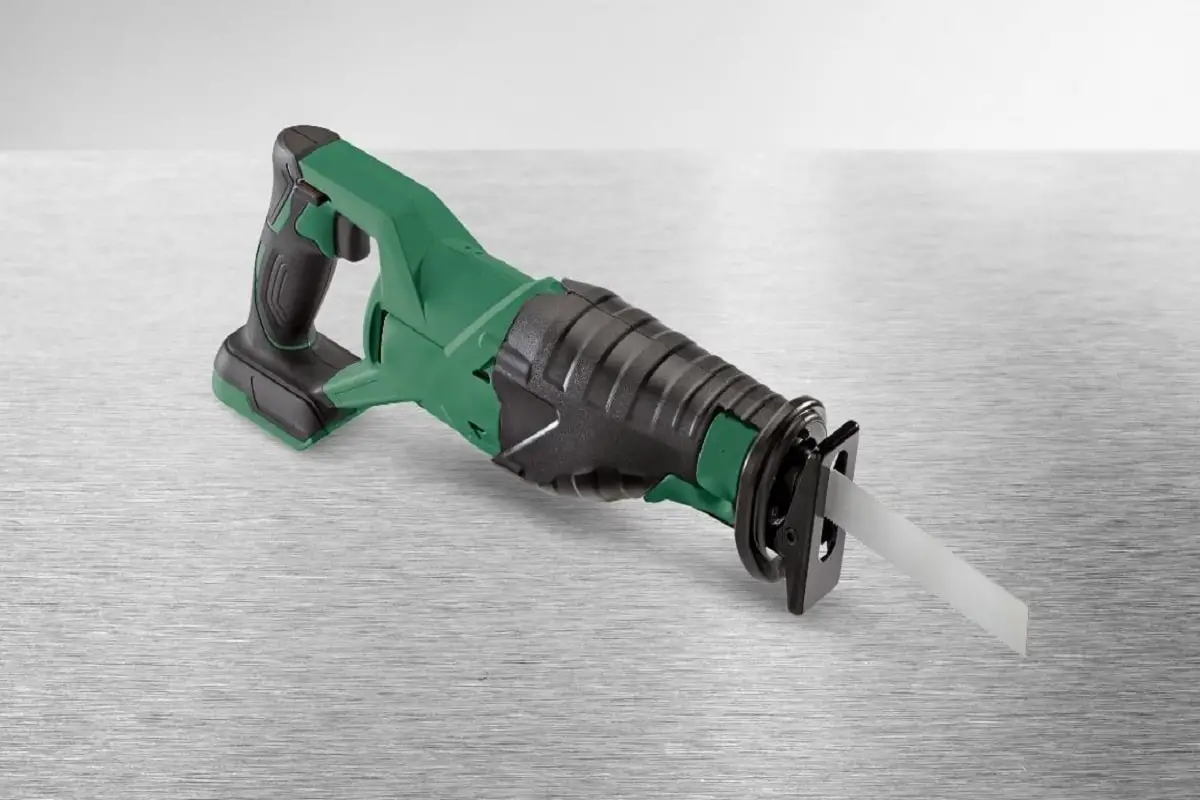Do you need a reciprocating saw? If so, what type should you get? Let’s find out in this post.
Types Of Reciprocating Saws
There are many different reciprocating saw jobs to be done out there. The reciprocating saw required for a specific task will determine which one you should use.
The reciprocating saw is an oscillating tool, and can be used to cut many different materials, using different blades. Generally, reciprocating saws vary based on their shape, weight, motor-power / motor type, and power source.
Here are some factors to consider when choosing a reciprocating saw:
- The materials being cut and the space allowed for cutting.
- Battery, corded, or pneumatic powered.
- For home or industrial cutting.
- Short versus long-term cutting tasks.
- The size and weight of the saw you can carry.
Each person will have their own unique requirements from the saw, which vary. Keep reading to find out more about each type of reciprocating saw.

Brushless Reciprocating Saw
A brushless reciprocating saw uses a brushless motor which is often advertised to provide longer runtimes and faster speeds. A brushless motor moves electronically using magnets and a step controller. Unlike a conventional motor, they do not use brushes, which can become worn down over time due to friction. Conventional brush motors also tend to heat up more quickly and this can decrease performance.
So, for these reasons a brushless reciprocating saw may be worth considering.
Battery-Powered Reciprocating Saw
Reciprocating saws powered by rechargeable batteries are now very common. They have a built-in battery slot where the user can attach the battery to power the saw.
Battery powered reciprocating saws allow for more range than corded versions. However the battery must be recharged, which means that a wall outlet and charger will need to be nearby. The cordless version is best suited to outdoor use where a plug-in is not available.
Buying an additional backup batteries is recommended just in case the first one runs out of juice. When working with reciprocating saws it is always recommended to have a spare battery available.
There should not be a noticeable drop in saw power when using a battery version versus a corded version. However, as the batter runs down, the saw may noticeably lose its cutting ability.
Reciprocating Saw Battery
Battery sizes range from 9 to 36 volts. Charging a battery will take between 30 minutes and 1.5 hours. A reciprocating saw battery will last between 30 minutes and 2 hours of continuous use, depending on model and quality.
Reciprocating Saw With Power Cord
Corded reciprocating saws have been around since the tool was first manufactured. Corded reciprocating saws are excellent for cutting in places where an outlet or generator is available.
Corded reciprocating saws have the benefit of never running out of power, so they can be used continuously until the job is done. However, the risk is that the user will trip on the cord or cut it accidentally. The range of the saw is also limited to the nearest wall outlet.
Reciprocating Saw Power Cord
The cord is usually attached at the rear of the saw near below the handle. Corded reciprocating saws supply power measured in “amps” and they generally range between 7 to 15 amps.
Corded reciprocating saws are often larger than battery powered versions. They can be medium, large, and heavy duty, and are great for both home and industrial cutting applications.
Mini Reciprocating Saw
Mini reciprocating saws are smaller than ordinary versions and are made for cutting materials in tight spaces. Mini reciprocating saws are also called “compact reciprocating saws.”
Mini reciprocating saws come in corded or cordless versions. Cordless mini reciprocating saws will use the same sized batteries and blades as larger saws, so they are interchangeable.
Mini reciprocating saws are smaller and lighter (and therefore easier to carry) and take up less space for storage. They can be carried and operated with one or two hands, and many people prefer to use them because of this reason.
Mini reciprocating saws are often preferred by HVAC and plumbing professionals for cutting in tight crawl spaces.
Heavy Duty Reciprocating Saw
Heavy duty reciprocating saws are larger and more powerful than ordinary versions. They are in the 15+ Amp range and weigh 10+ lbs. These are usually corded with a length of 8 or more feet.
Heavy duty reciprocating saws are made for rugged industrial cutting jobs. They are heavier so require a person able to handle them.
Air Reciprocating Saw
Air reciprocating saws are also called “pneumatic reciprocating saws.”
These are often more powerful than ordinary reciprocating saws because they can deliver more strokes per minute. They are able to cut thicker steel than regular saws.
These saws are are long and thin and resemble a large cooking knife. Air reciprocating saws are mostly used in industrial or professional settings, such as machine shops, gas and oil companies, and power plants.
However, they require a high powered air compressor to provide power. The capacity of the air compressor determines the power of the saw. This ranges from 4 to 30 cubic feet per minute (CFM).
Underwater Reciprocating Saw
Underwater reciprocating saws are made for divers and underwater rescue and demolition teams. They are fully waterproof and will function while submersed up to 100+ feet in depth.
In Closing
Reciprocating saws are very flexible cutting tools, and one version can be used for many different cutting tasks. When choosing which type to purchase, consider how you will use it. Just remember, reciprocating saws can cause injuries so wear proper PPE and keep safety in mind when using them.
